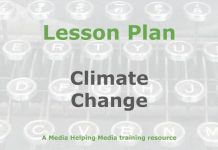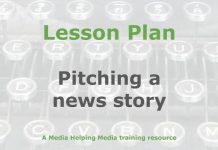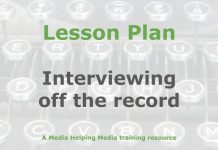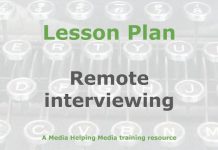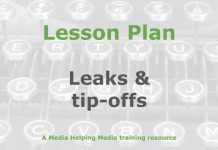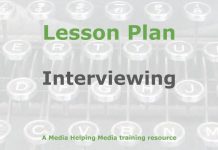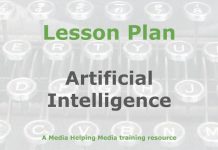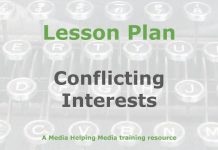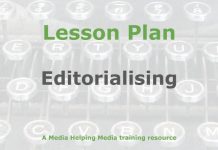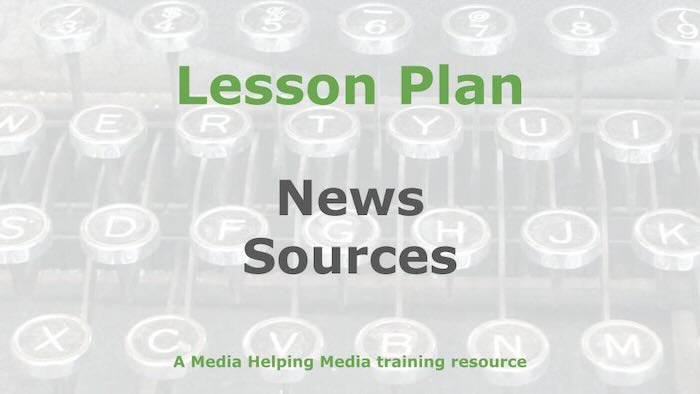 This lesson plan is designed to help journalists understand the sources of news stories and be able to order them in terms of their relevance to the audience.
This lesson plan is designed to help journalists understand the sources of news stories and be able to order them in terms of their relevance to the audience.
It’s based on the article Where does news come from? which is published on Media Helping Media. We suggest trainers read the original article before adapting the lesson plan below to meet their needs.
Learning objective
Students will evaluate news stories to determine their value to the audience, focusing on relevance, timeliness, and impact. They will categorise stories into areas such as conflicts, disasters, progress, crime, and human interest.
- Student-facing objective: By the end of this lesson a student will be able to assess news stories and decide which are most important for their audience, based on their relevance and impact.
- Standards: To help journalism students to identify news stories based on their value to the audience.
Learning activities
Warm-up
Display a series of headlines from various news categories: conflicts, disasters, progress, crime, and human interest. Ask students to identify which category each headline belongs to. Encourage them to think about the defining characteristics of each category. After a few minutes, discuss as a class, focusing on the reasoning behind their categorisations. This primes students for evaluating news stories based on their value to the audience.
Direct instruction
- Introduce news values: Explain the concept of news values, focusing on relevance, timeliness, and impact. Use real-world examples to illustrate each value. For instance, discuss a recent election (conflict) and its impact on local policies, emphasising why it is newsworthy.
- Categorise news stories: Present a list of recent news events. Ask students to categorise each event into one of the main news areas: conflicts, disasters, progress, crime, or human interest. Discuss the reasoning behind each categorisation, highlighting how these categories help determine a story’s news value.
- Evaluate newsworthiness: Provide students with a set of news stories. Have them evaluate each story’s newsworthiness based on the discussed values and categories. Encourage them to consider the audience’s perspective. Facilitate a class discussion to compare evaluations and explore different viewpoints on what makes a story valuable to an audience.
Guided practice
Think, Pair, Share: Guide students through a structured discussion to deepen their understanding of news values.
- Think: Present a recent news story. Ask students to individually consider its relevance, timeliness, and impact. Have them jot down their thoughts on why this story is newsworthy.
- Pair: Instruct students to pair up and share their evaluations. Encourage them to discuss any differences in their assessments and explore the reasons behind their perspectives.
- Share: Facilitate a class-wide discussion where pairs share their insights. Highlight diverse viewpoints and emphasise the importance of audience perspective in evaluating news stories.
- Refine: Ask students to refine their initial evaluations based on the discussion. Encourage them to consider new angles or factors they hadn’t initially thought of.
- Reflect: Conclude with a brief reflection on how understanding news values can influence the way journalists report stories and how audiences perceive them.
Independent practice
- News story analysis: Provide students with a set of diverse news stories. Instruct them to independently analyse each story, focusing on its relevance, timeliness, and impact. Have them categorise each story into one of the areas: conflicts, disasters, progress, crime, or human interest.
- Evaluation exercise: Direct students to complete a related exercise where they evaluate the newsworthiness of additional stories, considering the audience’s perspective.
- Reflection: Ask students to write a brief reflection on how their understanding of news values has evolved through the exercise. Encourage them to consider how these values influence their perception of news stories.
Circulate throughout the class to observe students as they work and provide support as needed.
Assignment
Ask students to answer these questions:
- Which news value do you think is most important when evaluating a story, and why?
- How does categorising a news story help determine its value to the audience?
- What’s one question you still have from today’s lesson?
Here are some suggested answers:
- Suggested answer to Question 1: Relevance, because it determines how the story affects the audience directly.
- Suggested answer to Question 2: Categorising helps identify the story’s impact and relevance, making it easier to assess its newsworthiness.
Teacher resources
Differentiation guide
- Advanced learners: Encourage deeper analysis by having them explore the nuances of news values in different cultural contexts. Challenge them to identify and discuss potential biases in news reporting. Suggest they create a presentation on how news values differ globally.
- Striving learners: Simplify tasks by providing structured templates for news story analysis. Use graphic organisers to help them categorise stories. Pair them with peers for collaborative evaluation exercises to build confidence and understanding.
- Background reading: We recommend you read the article Where does news come from? before adapting this lesson plan for your own requirements.
Notable definitions
- News values: Criteria that determine the importance of a news story, including relevance, timeliness, and impact.
- Newsworthiness: The quality of a news story that makes it interesting or important enough to be reported.
- Human interest: A type of news story that focuses on the experiences and emotions of individuals, often highlighting unusual or inspiring aspects of their lives.
Required materials
- Headlines: A selection of recent news headlines from various categories.
- News stories: A set of diverse news stories for analysis.
- Writing materials: Paper and pens for note-taking and reflections.
- Digital devices: Computers or tablets for accessing online news sources and exercises.
- Projector/screen: For displaying headlines and news stories to the class.
- Graphic organisers: Templates to help categorise and evaluate news stories.
Lesson summary
- Warm-up
- Direct instruction
- Guided practice
- Independent practice)
- Assignment
The free teaching tools at the Khan Academy were used as a basis for converting the original article into a lesson plan.
Related article
